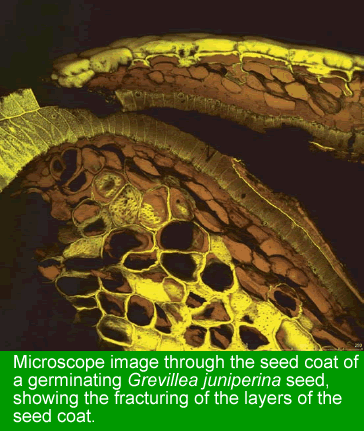
Summary of final report on the Australian Flora Foundation funded project:
Mechanical constraint model of seed coat dormancy in Grevillea
E. Charles Morris and Candida Briggs, School of Natural
Sciences, Hawkesbury Campus, University of Western Sydney
Grant Details Final Report
Dormancy of seeds in some East Australian Grevillea species is controlled by the seed coat, as excised embryos germinate fully. This project investigated whether the mechanical constraint mechanism of seed coat dormancy applied in Grevillea juniperina and G. linearifolia. The anatomical basis of breaking of the seed coat by the emerging radicle was investigated using confocal light microscopy. The force required to break through the seed coat was investigated by applying a force from the interior of bisected seed coats (with the embryo removed), in an attempt to simulate the action of the radicle. Compressive forces were applied to seeds from the outside, as a comparison. Both these methods were used on control, and heated and smoked seeds, to determine whether the fire cues affected seed coat strength. The maximum force that the embryos could develop in osmoticum over a range of water potentials was examined for control, and heated and smoked seeds.
The anatomical investigations showed that as the radicle began to grow, it forced apart the inner and outer micropyle, with ractures running between cells, along the cell walls, extending through the layers of the seed coat to the
exterior. The tip of the radicle emerged to the outside through the dorsal seed coat near the micropylar tip of the seed, rather
than through the tip itself. Estimates of the force required to break through the seed coat from the inside ranged from 0.1 – 0.4
MPa after one day of imbibition; there was no significant difference between the control or treated seeds in the force required. The force required after 14 days of imbibition was slightly less than after one day, but still not significantly different between treatments. The method used to estimate the force required to break through the seed coat from the inside was difficult to implement, and the results must be treated with caution as a result. The compressive force required to break the seed coat after one day of imbibition did not differ with treatment either; however, there was weak evidence of a shift in the shape of the frequency distribution with treatment, which would be consistent with the seed coat of some proportion of heated and smoked seeds being weakened by one or both of the fire cues. More work would be required to substantiate whether this very tentative conclusion is correct. The maximum force that could be exerted by half-excised embryos was at least 0.3 MPa for G. juniperina, and at least 0.4 MPa for G. linearifolia. The range of water potentials used did not allow determining what the full maximum force was for either species, and whether the fire cues altered this maximum force. Further work is required to confirm the tentative conclusions that it was possible to reach in this work
